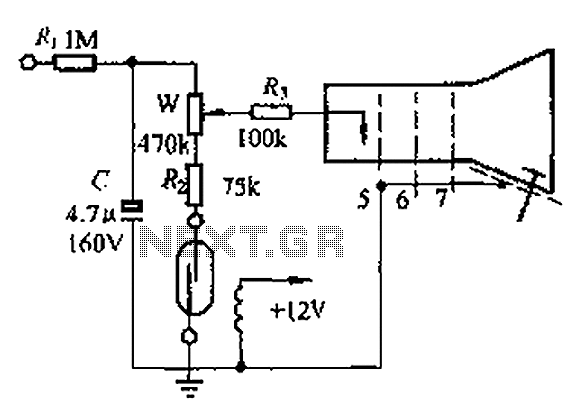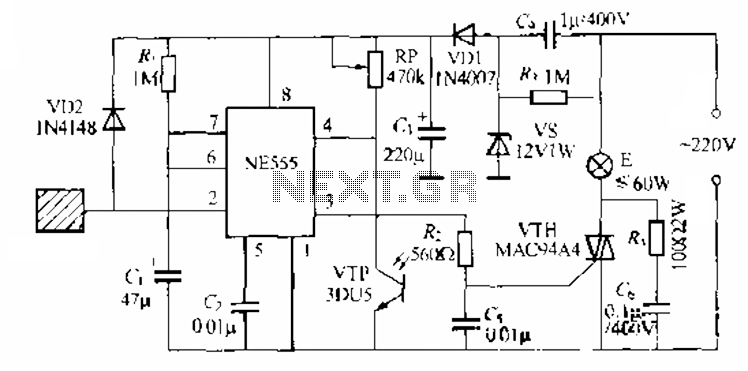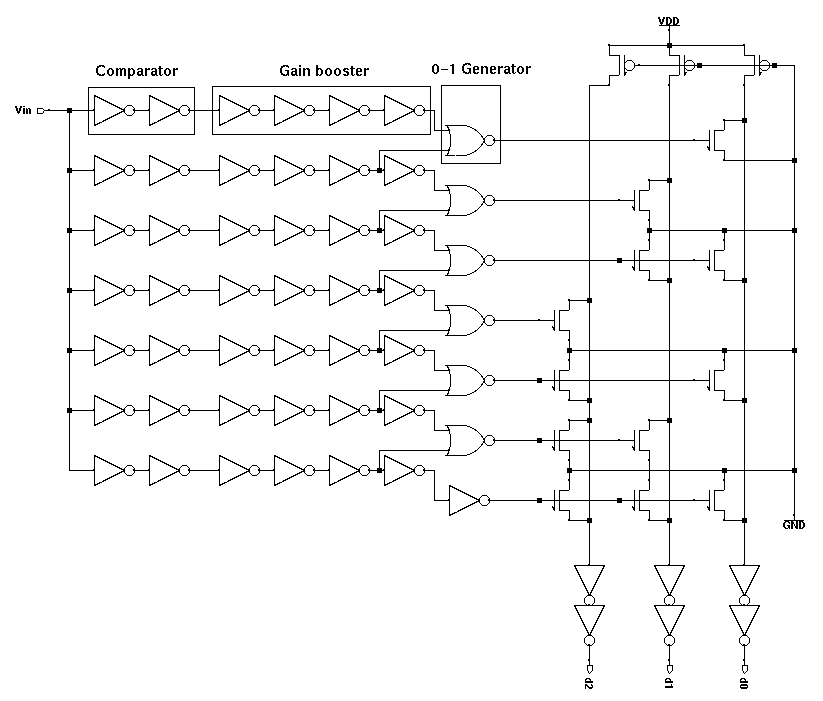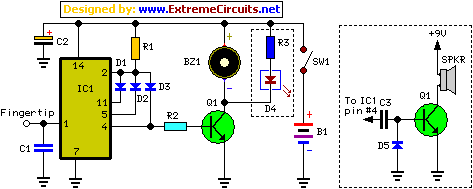
Knight Rider Running Light Schematic

The speed of the display can be adjusted as desired. The output from the 555 timer is directly connected to the input of a CD4017 decade counter. The input of the counter is referred to as the CLOCK line (from the 555 timer). The ten outputs of the counter activate sequentially, one at a time, with each rising edge of the waveform generated by the 555 timer. Each output can provide approximately 20 mA; however, it is essential to include a current-limiting resistor (220 ohms as indicated in the circuit) when connecting an LED to the output. The first six outputs of the CD4017 are connected directly to six LEDs, which create a moving effect across the display. The subsequent four outputs reverse the movement, and this cycle continues. The animation illustrates how the effect appears on the display. By utilizing six LEDs, the display can be positioned at the front of a model car to create a very realistic effect.
The described circuit utilizes a 555 timer IC configured in astable mode to generate a continuous square wave output, which serves as a clock signal for the CD4017 decade counter. The frequency of the output waveform from the 555 timer can be adjusted by changing the values of the resistors and the capacitor connected to it, thus allowing for control over the speed of the LED animation.
The CD4017 decade counter features ten outputs, each capable of driving a load of up to 20 mA. This makes it suitable for driving standard 5mm or 3mm LEDs, provided that a current-limiting resistor is placed in series with each LED to prevent excessive current flow, which could damage the LED. The typical value for the current-limiting resistor is 220 ohms, as noted in the circuit description.
In the application of this circuit, the first six outputs of the CD4017 are wired to six LEDs, creating a sequential lighting effect that can be visually appealing. When the clock signal from the 555 timer rises, the first output activates, lighting the first LED. As the clock continues to pulse, the subsequent outputs activate in sequence, resulting in a "moving" effect across the display.
The remaining four outputs are configured to reverse the direction of the LED sequence, creating a dynamic back-and-forth animation. This cycling of outputs provides a continuous visual effect that can enhance the aesthetic of model cars or other projects. The circuit is relatively simple and can be easily integrated into various designs, making it a popular choice for hobbyists and engineers alike. Proper attention to component specifications and connections will ensure reliable operation and longevity of the circuit.It can be adjusted to give the desired speed for the display. The output of the 555 is directly connected to the input of a CD 4017. The input of the counter is called the CLOCK line (555). The 10 outputs become active, one at a time, on the rising edge of the waveform from the 555. Each output can deliver about 20mA but a LED should not be connected to the output without a current-limiting resistor (220 © in the circuit above). The first 6 outputs of the chip are connected directly to the 6 LEDs and these move across the display. The next 4 outputs move the effect in the opposite direction and the cycle repeats. The animation above shows how the effect appears on the display. Using 6 LEDs, the display can be placed in the front of a model car to give a very realistic effect. 🔗 External reference
The described circuit utilizes a 555 timer IC configured in astable mode to generate a continuous square wave output, which serves as a clock signal for the CD4017 decade counter. The frequency of the output waveform from the 555 timer can be adjusted by changing the values of the resistors and the capacitor connected to it, thus allowing for control over the speed of the LED animation.
The CD4017 decade counter features ten outputs, each capable of driving a load of up to 20 mA. This makes it suitable for driving standard 5mm or 3mm LEDs, provided that a current-limiting resistor is placed in series with each LED to prevent excessive current flow, which could damage the LED. The typical value for the current-limiting resistor is 220 ohms, as noted in the circuit description.
In the application of this circuit, the first six outputs of the CD4017 are wired to six LEDs, creating a sequential lighting effect that can be visually appealing. When the clock signal from the 555 timer rises, the first output activates, lighting the first LED. As the clock continues to pulse, the subsequent outputs activate in sequence, resulting in a "moving" effect across the display.
The remaining four outputs are configured to reverse the direction of the LED sequence, creating a dynamic back-and-forth animation. This cycling of outputs provides a continuous visual effect that can enhance the aesthetic of model cars or other projects. The circuit is relatively simple and can be easily integrated into various designs, making it a popular choice for hobbyists and engineers alike. Proper attention to component specifications and connections will ensure reliable operation and longevity of the circuit.It can be adjusted to give the desired speed for the display. The output of the 555 is directly connected to the input of a CD 4017. The input of the counter is called the CLOCK line (555). The 10 outputs become active, one at a time, on the rising edge of the waveform from the 555. Each output can deliver about 20mA but a LED should not be connected to the output without a current-limiting resistor (220 © in the circuit above). The first 6 outputs of the chip are connected directly to the 6 LEDs and these move across the display. The next 4 outputs move the effect in the opposite direction and the cycle repeats. The animation above shows how the effect appears on the display. Using 6 LEDs, the display can be placed in the front of a model car to give a very realistic effect. 🔗 External reference





